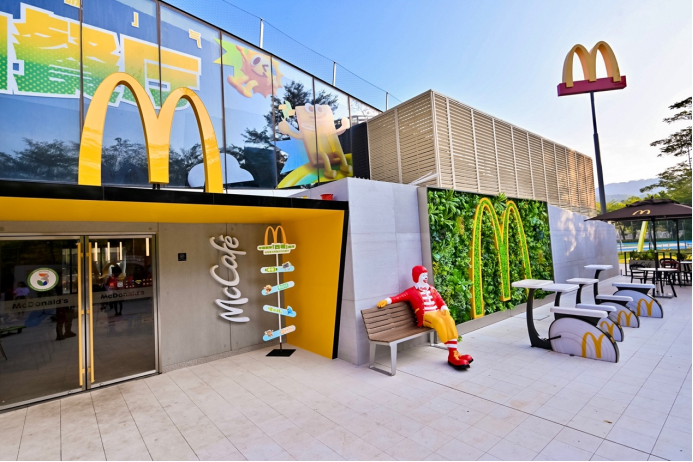From: Shenzhen Daily | Updated:2024-11-05
In mid-October, McDonald’s opened China’s first “Four-Zero” restaurant — the Dameisha Vanke location—at the Biosphere 3, Dameisha Vanke Center Carbon Neutral Experimental Zone in Shenzhen’s Yantian District.

This pioneering restaurant meets all four criteria for LEED net-zero certification: Zero Carbon, Zero Energy, Zero Waste, and Zero Water, setting a new standard for sustainability in China’s fast-food industry. LEED, which stands for Leadership in Energy and Environmental Design, is the world’s most widely recognized green building rating system.
The Biosphere 3 zone, where the McDonald’s Dameisha Vanke restaurant is located, was developed with a commitment to eco-friendly practices. Featuring sustainable design, materials, and technologies, the center serves as a model carbon-neutral site and a near-zero carbon pilot project in Shenzhen. The center’s advanced green infrastructure—including solar energy, rainwater harvesting, and waste recycling—supports the new restaurant in achieving its ambitious environmental goals.

“This innovative restaurant marks McDonald’s latest step in expanding our green footprint in China,” said Phyllis Cheung, CEO of McDonald’s China. “Since 2018, we have designed new restaurants to meet LEED standards, and over 3,300 of our 6,500 locations now carry LEED green certifications. The McDonald’s Dameisha Vanke restaurant will be the first in China—and possibly the world—to achieve all four LEED net-zero certifications. It is a new starting point for us to leverage our brand to serve both communities and the environment,” Cheung noted.
The “Four-Zero” initiative significantly reduces the restaurant’s environmental impact. All electricity is sourced from solar panels on the Dameisha Vanke Center’s rooftop, resulting in a nearly zero carbon footprint. The restaurant also uses an advanced waste management system, processing food waste on-site through a “black soldier fly composting” method that transforms waste into reusable resources, supporting a zero-waste model. Additionally, rainwater and greywater are collected and recycled for kitchen use, maintaining a zero net water footprint.
The restaurant incorporates other sustainable technologies as well. Around 70% of its cooling equipment uses low global warming potential (GWP) refrigerants, reducing the potential for global warming by 70%. In a first for McDonald’s China, the restaurant also uses “carbon-sequestering bricks” that trap approximately 380 kg of CO2 within the building’s walls—an amount equivalent to what a palm tree absorbs over 37 years.
Inside the restaurant, all building materials are GREENGUARD certified to minimize chemical emissions, while 90% of the equipment holds Energy Star certification, reducing electricity demand overall. Smart energy management systems enhance operational efficiency and further reduce emissions, while air conditioning and lighting are digitally managed to optimize both customer comfort and energy use.
Wang Shi, the founder of Vanke Group and chairman of the Vanke Foundation, highlighted the larger implications of the project. “Building green communities is not only a corporate responsibility but a commitment to the future. This collaboration with McDonald’s injects fresh energy into our shared vision and encourages more companies to join the green transition,” Wang said.
Jing Wang, Vice President of the U.S. Green Building Council, North Asia, praised McDonald’s China for its green leadership: “LEED net-zero certification has become a beacon in sustainable building. We are thrilled to see consumers experiencing this green dining model at McDonald’s and hope this inspires more people to adopt low-carbon lifestyles.”
About LEED Zero
LEED Zero certification is an innovative add-on to the original LEED rating system, recognizing buildings that achieve net-zero performance in carbon emissions, water use, energy use, or waste management over 12 months.
GREENGUARD Certification
GREENGUARD Certification is a widely recognized environmental certification program, primarily focusing on indoor air quality. Developed by UL Environment, GREENGUARD certifies products and materials that meet strict chemical emissions limits, ensuring that they contribute to healthier indoor environments by releasing fewer pollutants and volatile organic compounds (VOCs) into the air.
Energy Star
ENERGY STAR is a U.S. government-backed certification program managed by the Environmental Protection Agency (EPA) that promotes energy efficiency. Launched in 1992, the ENERGY STAR label helps consumers, businesses, and organizations identify products, buildings, and appliances that meet strict energy efficiency guidelines, saving energy, reducing greenhouse gas emissions, and lowering utility costs.
McDonald’s Restaurants Certified by LEED in China
As of September 2024, more than 3,300 McDonald’s locations across mainland China have earned LEED green certification, spanning 29 provinces, cities, and autonomous regions — making it the world’s largest group of LEED-certified restaurants. Together, these green-certified restaurants reduce carbon emissions by approximately 109,000 tons each year, the equivalent of planting 10.9 million trees.
Including the flagship Meisha Vanke location, McDonald’s China has opened three “Zero Carbon” restaurants across the country by October 2024:
1. Shougang Park Drive-Thru, Beijing (opened September 2022)
?The world’s first restaurant certified for both “Zero Carbon” and “Zero Energy” under LEED.
?Solar panels cover more than 2,000 square meters, generating approximately 330,000 kWh annually, enough to meet the restaurant’s entire energy needs, reducing carbon emissions by around 200 tons each year.
2. Yunshan Tian Di Restaurant, Guangzhou (opened March 2024)
?Designed and built to meet LEED Zero’s “Zero Carbon” standards, using a “solar power plus energy storage” model, making it China’s first integrated solar-storage “Zero Carbon” restaurant.
?Solar panels on the restaurant’s roof produce about 55,000 kWh annually, covering all lighting needs. With energy storage, the restaurant efficiently supplies green energy around the clock, optimizing energy use.